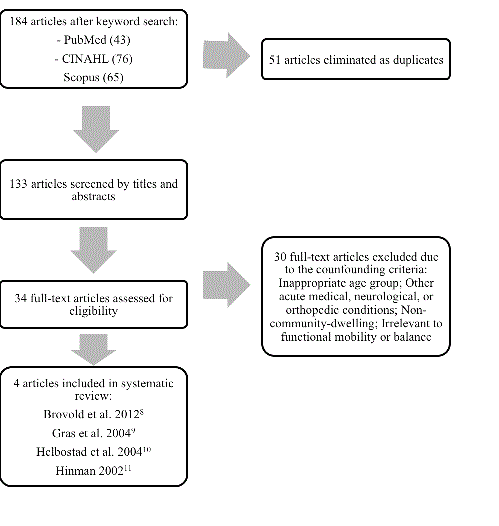Research Article Open Access
Older Adult Compliance with Physiotherapy-Prescribed Home Exercise for Balance: A Systematic Review
| Knight E, Judge K, Tang M and Vandervoort AA* | |
| School of Physical Therapy, University of Western Ontario, London, Ontario, Canada | |
| Corresponding Author : | Dr. Anthony A. Vandervoort Professor, School of Physical Therapy University of Western Ontario, Elborn College Room 1400, London, Ontario, Canada Tel: 519-661-2111, ext. 88844 E-mail: vandervo@uwo.ca |
| Received April 28, 2014; Accepted May 19, 2014; Published May 21, 2014 | |
| Citation: Knight E, Judge K, Tang M, Vandervoort AA (2014) Older Adult Compliance with Physiotherapy-Prescribed Home Exercise for Balance: A Systematic Review. J Nov Physiother 4:212. doi:10.4172/2165-7025.1000212 | |
| Copyright: © 2014 Knight E, et al. This is an open-access article distributed under the terms of the Creative Commons Attribution License, which permits unrestricted use, distribution and reproduction in any medium, provided the original author and source are credited. | |
Visit for more related articles at Journal of Novel Physiotherapies
Abstract
Purpose: Impaired balance is a significant cause of falls among community-dwelling older adults. The purpose of this systematic review was to examine current evidence on the compliance of men and women over 60 years of age with home exercise programs for balance prescribed by a physiotherapist, and to explore the relationship between compliance and patient outcomes.
Method: Electronic databases were searched (PubMed, Scopus, CINAHL) between December 2012-January 2013. Strict a priori inclusion criteria were used to identify eligible articles, which were scored using a modified Downs and Black checklist by two independent reviewers.
Results: Four articles met inclusion criteria. The results of these studies revealed self-reported compliance rates between 50% and 97%; however, compliance appeared to vary depending on the level of clinician supervision and type of compliance measure. Two studies showed no functional gains in balance, and two showed significant improvements in balance.
Conclusion: Based on the small number of eligible studies, compliance with home-based exercises prescribed for balance training among older adults varies, with increased compliance appearing to be associated with increased clinician supervision. Further research is required to determine the efficacy of physiotherapist-prescribed home exercise programs for functional balance outcomes.
Tables and Figures at a glance
| Table 1 |
Figures at a glance
 |
| Figure 1 |
Relevant Topics
- Electrical stimulation
- High Intensity Exercise
- Muscle Movements
- Musculoskeletal Physical Therapy
- Musculoskeletal Physiotherapy
- Neurophysiotherapy
- Neuroplasticity
- Neuropsychiatric drugs
- Physical Activity
- Physical Fitness
- Physical Medicine
- Physical Therapy
- Precision Rehabilitation
- Scapular Mobilization
- Sleep Disorders
- Sports and Physical Activity
- Sports Physical Therapy
Recommended Journals
Article Tools
Article Usage
- Total views: 14910
- [From(publication date):
July-2014 - Aug 15, 2025] - Breakdown by view type
- HTML page views : 10224
- PDF downloads : 4686
